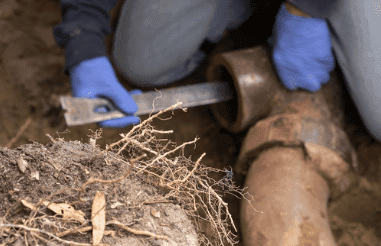When your home smells funny, it could signify that your sewer line is clogged. If this happens, it is time to contact a plumber to help you solve this problem. In most cases, the sooner the problem is addressed, the less likely it is to become a bigger issue. Even small repair jobs can help you save money and time. To learn more about sewer line problems, read on!
What could be a sign of a plumbing problem?
Clogged drains, slow water flow, or water pooling under your sink are common signs of a plumbing problem. If you notice any of these, you should call a plumbing service immediately. While most of these issues can be solved with a professional plumber, you should still pay attention to the signs to spot possible problems and avoid them worsening. Here are some warning signs that could be indicative of a plumbing problem.
A bubbling toilet seat can indicate a leak in the plumbing system. If the toilet base is shaky, you might need to tighten the seat. If the toilet is warped or stained, there may be a leak in the floor. Getting a plumber to inspect your home’s plumbing is a great idea before spending thousands of dollars fixing a problem.
Slow water drains are another sign of a plumbing issue. Getting water from the sink takes longer than usual, causing a foul smell. The drain might be clogged with debris, or there might be a leak in the sewer line. Often a slow drain is due to a clogged drain, but it can also be a sign of a more serious plumbing problem.
How do you know if your sewer line is clogged?
One of the easiest ways to determine if your sewer line is clogged is if your drains are slow. Overflowing water will travel to the pipe’s lowest part, usually the toilet or the bathtub. If you have a washing machine, this may also cause the toilet to overflow. Toilets with clogged lines can also make the overflow worse.
Another way to tell if your sewer line is clogged is when you flush the toilet. When this happens, your toilet will start to gurgle. Then, you may have tree roots growing through the sewer line. Tree roots enter the pipe through the joints, acting as a net for waste. Any of these signs should prompt you to contact a plumber immediately. If the clog is large, you may have to call a plumber.
While the simplest clogging is a minor problem, more advanced problems can require a full sewer line replacement. Fortunately, there are ways to prevent clogging. In some cases, cleaning out the blocked area and making spot repairs are enough to fix the problem. For more difficult clogs, a plumber may need a camera to diagnose the problem and offer an alternative solution.
What are the signs of a sewer line replacement?
Clogged or faulty pipes require professional plumbing repair, which can be very unpleasant. In addition to causing a huge mess, clogged pipes can pose a health risk. Here are a few of the most common signs that you should call a plumber:
Slow drains and frequent clogs are major warning signs that you should call a plumber for a sewer line replacement. You may also notice green patches on your lawn, increased pest activity, or a foul smell inside your home. If these signs are present, it may be time to call a plumber to have your sewer line inspected. The backed-up sewer line is the most obvious and grossest sign of a sewer line problem.
Besides the odour, a broken sewer pipe may also leave a patch on your lawn. If the sewage has soaked your lawn, it will be a valuable fertilizer. However, if you ignore the smell, it will only get worse. Luckily, a professional plumber can identify the cause of the problem and repair it. You may even notice a patch of sewage on your lawn due to a sewer line break.
What causes a broken sewer line?
Wet spots in your yard might indicate a sewer line problem. These spots could be from a broken septic tank or sewer line. The good news is that repairing a broken sewer line can save you money and time. Broken sewer lines often occur because of sedimentation or changes in the soil. Because sewage waste sits in the lower part of a sewer pipe, rodents and insects can squeeze through the smallest crack.
While broken sewer lines need immediate repair, not all are a cause for concern. Some pipes can break due to back-pitch or ground settlement. These types of breaks can lead to a backed-up sewer system. These problems can be a source of property damage and health risks. To prevent damage, you should know the warning signs of a broken sewer line. If you detect any of these symptoms, contact a plumber immediately.
Sewer lines are one of the most important systems in your home, so you must know how to keep them in good condition. Before you call a plumber, document the situation and the damage to the line. If a broken sewer line results from a negligent contractor, the plumber should make the necessary repairs for free. During this time, you should also contact an experienced plumber for repairs.
Are drain lines and sewer lines the same?
Whether your drain line is plugged or not, a clog could indicate a clog in your main sewer line, which will require a professional plumber’s help. In most cases, you can still use your other plumbing. Here are some things to keep in mind to avoid a mess and a call to the plumber.
Drainage pipes lead from your home or building to the municipal sewer. Drains are the responsibility of the homeowner and should be maintained regularly. In severe cases, digging up the yard may be necessary to fix the mainline. On the other hand, drain lines are repaired by a plumber working inside your home. To repair a drain line, call a licensed and insured plumber. If the line is blocked, call a plumber immediately.
When your drain stops working, it’s most likely clogs in your sewer line. This happens due to a break or individual pipe blockage. If you can’t find the clog, call a plumber for a professional inspection. There are many types of sewer lines, so hiring the right one is crucial. But how do you know which type of plumber to call? Here are some things to remember when calling a plumber for any plumbing problems.
When should we call a plumber?
Clogged drains can be very difficult to clean, and a clog in a sewer line could damage the pipe. A plumber can safely and thoroughly examine the clogged drain and repair it. In many cases, a clogged drain is not a sign of a problem, but a clogged drain can indicate a larger problem. Fortunately, there are several ways to avoid clogged drains. Regular drain cleaning and inspections can help prevent clogs and pipe problems. If your pipes are extremely old or cracked, a plumber can replace them with a new one.
One way to tell if you have a clogged drain is to smell it. If the drain has a foul smell, you may have a problem. The odor may be coming from the sewer. It may also be a result of city sewer work. If you have a sewage smell, call a plumber immediately. Depending on the cause of the problem, your plumber may need to perform a non-invasive solution first and then proceed with the excavation process.
If clogged drains are a problem, a plumber can clean them. This way, they can see the underlying problem and determine what repairs need. Sometimes, tree roots can clog sewer lines, but that’s not the only cause. Tree roots are the number one cause of sewer line back-ups. A plumber can use a video camera to identify the problem.
What does a sewer line leak look like?
If you have a slow drain, your pipe is leaking sewage. Before you call a plumber, try using a plunger to clear the clog. This will help you determine the source of the leak. If the drain still clogs, a leak could cause the waste to build up. To determine if your pipe is leaking, check your drain regularly.
A sewer line leak can leave your yard sunken and smelling like sewer water. The extra fluid from a leaking line compacts dirt and saturates the ground. The culprits of these leaks are either old pipelines or invasive tree roots. Unusual watery spots may also be signs of a leaking sewer line. Additionally, mold may grow in the water caused by a leaky pipe. Mold grows at 55% humidity.
Performing a dye test can also reveal the source of the leak. If the leak is slow, you may not notice any symptoms for months. You may notice dark rings, damp spots, or discoloration on your walls. The color will vary, so be sure to use a colored liquid to ensure you find the source. Do not forget to check your home’s water pressure as well. If it has dropped significantly, there could be a leak in your municipal water supply.
Conclusion
It’s important to know what’s causing your sewer line issues to fix them. A typical sewer system in a home is composed of one main sewer line and several branch lines that connect to the bathtubs, toilets, sinks, and other water sources throughout the house. In addition to hauling waste from your home to the main sewer system, your main sewer line also transports the waste to the water treatment plant. If you have a clogged sewer line, you may notice a foul odor from your sink, tub, or drain in the basement. You likely have a clogged pipe if you smell sewage. When you have a sewer line problem, your sinks, toilets, and even bathtub may drain slowly or not at all.



